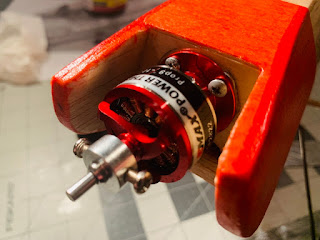The fuselage is taking shape and by following the advice in the build article I turn my attention to the tail section and build the stabilizers, elevator and rudder. I used 3/32" balsa instead of 1/16" for a more sturdy structure. 3/"32 balsa was still too thin for nylon hinges and for a retro look I went with hinges made out of white silk span, which is an idea I got at the hobby shop while chatting with the owner about my plans for the silk span I purchased. Once again, my magnet board was useful in achieving a perfect right angle between the horizontal stab and the fin. Once dry, I fitted the stabilizers onto the fuselage, with the top-wing pylon, and completes the top sheeting. here are some close views or the work so far after some basic sanding. And the overall look of the model with dry fitted wings. The fuselage weighs about 77 grams, which is so far much below my target. I still need to add the battery compartment cover with magnets, landing gear, and push-rods.





